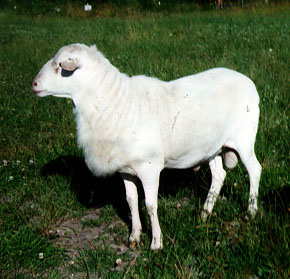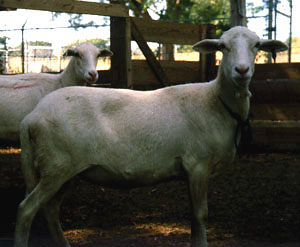St. Croix Sheep
Also Known As: Virgin Island White, White Virgin Islander, White Virgin Island
The Virgin Island White breed is found in the U.S. and British Virgin Islands in the Caribbean. It is believed to have descend from the hair sheep of west Africa, but some feel it is a cross of the Wiltshire Horn and the native Criollo. Most of these sheep are white with some solid tan, brown, black or white with brown or black spots. Both sexes are polled, and rams have a large throat ruff. Mature Virgin Island White ewes and rams weigh 35 and 45 kg, respectively.
Twenty-five Virgin Island White sheep, 22 ewes and 3 rams, were selected in St. Croix and imported into the U.S. by Dr. W. C. Foote of Utah State University in 1975. There were no records available on the animals. The criteria for selection were white color, lack of wool and average or better body size and conformation. These sheep were the basis of the present St. Croix breed in the U.S. The size of the ewes in the U.S. averages 119 lbs, while the rams average 163 lbs. St. Croix ewe's lambs show high fertility at 6-7 months of age. Lambing rate varies from 150-200% with two lambings a year not uncommon. They are being used in production and cross breeding studies in Utah, as well as California, Florida, North Carolina and Ohio. Purebred lines have been maintained, and as numbers increase, animals have been released to private breeders.
The St. Croix has been shaped by natural as well as human selection. As a result, they are climate adapted, fertile and excellent foragers. Exceptional parasite resistance compared to British sheep breeds has been documented in studies at several universities. While they can withstand high heat and humidity better than British sheep breeds, they have adapted to variable climatic conditions in many parts of the country. In colder zones they produce a very heavy winter coat of mixed wool and hair that is shed in the spring.
Birth weights average 6-7 lbs. A mature ram can weigh 200 lbs, and a ewe can weigh 150 lbs. They are easy to handle, and are active and vigorous but show no tendency to be wild. They are generally more resistant to internal parasites than conventional sheep. The ewes can breed back after one month after lambing. Ewes can produce two lamb crops per year. Lambs are usually twins, some singles, often triplets and occasionally quadruplets.
The St. Croix is reported to be a docile, calm breed with good flocking instincts. Their adaptations to many of the problems experienced in tropical and sub-tropical regions would seem to make them a prime candidate for sheep production in those areas.
Status: RARE. There were 300 registrations in 1990, up from 135 in 1985. The breed is unique to North America.
For more information:
References
Taking Stock. The Livestock Conservancy, Box 477, Pittsboro, North Carolina U.S.A. 27312, Phone: (919) 542-5704
Thomas, D.L., Hair Sheep Genetic Resource of the Americas. Proceedings Hair Sheep Research Symposium (ed. Stephan Wildeus). 1991. University of the Virgin Islands.
Correspondence: Garry Vroegh, Dutch Heritage Farm
Email: a043140t@bcfreenet.seflin.lib.fl.us



